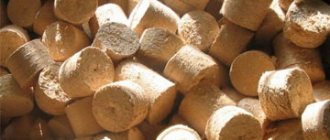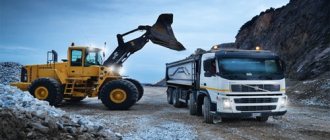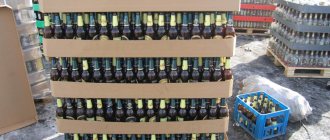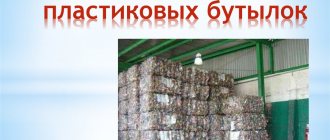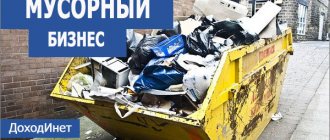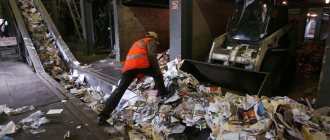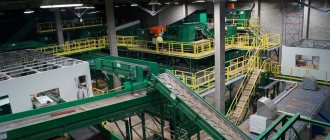Equipment for waste processing and disposal solves two important problems at once, related simultaneously to economics and ecology:
- Allows you to extract maximum benefit from “unnecessary” waste, turning it into high-quality and inexpensive raw materials for the manufacture of new products.
- Prepares waste that cannot be recycled for safe disposal or complete destruction.
Modern industry offers a wide selection of equipment for working with different types of waste.
As a rule, at the first stage, the waste is sorted, for which sorting lines and conveyors are used. After which the waste is crushed using crushers, shredders and shredders. And special separators help clean raw materials from unnecessary impurities - for example, separate plastic from iron.
If we are talking about particularly hazardous waste, then at the first stage they must be neutralized or decontaminated - and special installations and production lines are also used for this.
Garbage presses and compactors reduce the volume of waste, and further packaging (for example, using balers) turns waste into blocks convenient for transportation and storage.
Mobile and stationary equipment
Main types of processing stations:
- Press.
- Shredder.
- Compactor.
- Sorting line.
Among them, each type can be:
- mobile,
- stationary.
Let's take a closer look at them.
Sorting lines
Most often it is installed in one permanent place. But it can also be used as a mobile installation, using movable elements. Designed for primary sorting of waste by type.
Shredders or crushers
They are in great demand in farming and on production lines. Basically, such vehicles are equipped with tracks or a wheeled chassis, with the help of which they can easily move from place to place.
Such mobile stations are good not only for recycling waste, but also for crushing stone, wood and other substances.
Waste recycling presses
Truly indispensable equipment for recycling and significantly reducing the size of waste. Such installations significantly increase the speed of waste transportation.
Compactors
Similar to presses: they also compress waste, making it more compact for storage and transportation. Mobile compactors differ from stationary ones in their dimensions and the volume that the station can process at a time.
A mobile installation is much smaller and is made in the form of one continuous block, and not divided into several sections, like a stationary one.
The importance of recycling
There are several reasons why proper waste recycling is necessary:
- Once in the environment, most substances and materials turn into pollutants (it is worth considering that our planet is already suffocating every day from emissions from cars and factories).
- Many of the resources from which certain materials are created are being exhausted. Their supplies are too limited, so recycling is the solution.
- In some cases, objects that have fulfilled their purpose turn out to be a source of substances. Moreover, they are cheaper than natural materials.
Typical equipment for processing recyclable materials
For processing and recycling of secondary raw materials, the following is used:
- Crushers.
- Granulators.
- Agglomerators.
We have already reviewed the functions and method of operation of the former. Let us now touch upon the basic principles of operation of the remaining installations for recycling by type of recyclable materials.
The granulator performs the functions of a press: the installation compresses the mass entering the input, producing granules of a certain shape at the output.
Feeding is carried out using a screw . The granulator is usually supplied with:
- Transport tape.
- Fan or other cooling device.
- Feeder or auger.
An agglomerator is a tool that performs full or partial processing of recyclable materials.
Can be used as a device for:
- washing,
- cleaning,
- agglomeration,
- grinding and drying of raw materials.
The resulting material is called agglomerate. It has the shape and appearance of pellets.
Profit and costs
Each waste processing technology is viewed through the prism of capital investment.
This approach involves dividing secondary raw materials into types:
- High quality products such as scrap metal or glass. They do not contain impurities, so their processing does not require enormous amounts of costs.
- Materials of average quality require the use of special technologies and capital comparable to the profit from the sale of processed products. This group includes textiles and waste paper.
- Difficult to recycle waste - polyethylene, broken glass and polymer residues. During their processing, valuable substances are extracted, and this requires certain costs.
- Special treatment methods and technologies are used for hazardous secondary waste. This is an expensive business from an economic point of view.
Solid waste processing technology
Specialized devices
Often the following devices are used as additional means:
- Shredders of paper, cardboard, waste paper;
- PET bottle piercers
- Packet Breakers.
Waste paper shredders
These are well-known shredders that are often used to destroy papers and documents. In production, such a machine has large dimensions and processing volumes.
Piercers
A very useful thing when recycling plastic bottles. Since most of them are thrown out with the lid closed, pressing leads to unnecessary energy consumption.
If you press the containers as they are, the air inside the bottles can lead to an explosion of the finished bale and injury at work!
A piercer can solve this problem: it pierces the bottles, and the press squeezes the air out of them, making the output material as compact as possible.
Packet Breakers
Used for recycling household waste. The breaker has the form of a broaching block with a metal body.
Essential elements:
- cutting part,
- limiters for the height of the supply layer and loading of the supplied material.
Different variants
Each type of raw material has its own processing technology:
- Sorting waste into small fractions precedes waste disposal and recycling. This process can be carried out manually or using special machines. Consumed materials are reduced in size as their constituent components are crushed and sieved.
- One of the most common methods is burning. It allows you to obtain additional products necessary for the production of electricity and heat supply. The fire method reduces the amount of waste used by 10 times. Since innovations are aimed at renewing resources, the government of many civilized countries encourages their implementation, abandoning the usual burning of waste. Scientists have recognized that this method is expensive and has an adverse effect on human health. During combustion, toxic substances are released into the atmosphere that can cause cardiovascular and respiratory diseases. Therefore, waste processing by combustion must be carried out in special installations or incineration plants, taking into account all rules and requirements. Waste incinerators, depending on the type of furnace, use different waste processing technologies, for example, layer combustion, fluidized bed method, pyrolysis, gasification.
- Composting technology is used in agriculture and livestock farming. It is based on natural reactions. Microorganisms that live in the soil and in organic waste process the source material. As a result, a new product is formed - compost, which can be used as fertilizer. Composting is a useful way of recycling waste, as it retains moisture, saturates the soil with useful substances and improves its condition. Over time, it was improved: in practice, heated sealed installations began to be used to speed up the decomposition process.
- The earth filling of animal waste involves the production of biogas for its further use as organic fuel. This process is carried out at special testing sites. Processing takes place in the depths of the earth, where ideal conditions are created for the proliferation of microscopic bacteria. An industrial installation with ventilation pipes, gas collectors, boilers and tightly closing containers is built in there. Biomass decomposition occurs in stages and over a certain period.
Additional options
In addition to the main set of tools used in waste processing plants, additional ones are often used, for example:
- Pyrolysis ovens.
- Glass processing and remelting equipment.
- Devices for specialized processing of a specific material.
Pyrolysis furnaces are used to burn tires and separate gas and carbon black .
A very important point is that recycling tires in such ovens does not affect the environment .
After this type of rubber processing, carbon black is sold at a considerable price .
In production, there is often a need for more convenient processing of a certain type of waste. The more advanced the plant, the more various devices and machines it has for processing; you can additionally purchase the following equipment:
- Shredders for grinding a certain type of material (glass, waste paper, solid waste).
- Additional means for more thorough processing (piercers, tearers, shredders).
- Washing, drying, ovens, etc.
Modern methods of thermal processing of solid waste
The Gintsvetmet Institute, together with other Russian organizations, has developed a technology for thermal processing of solid waste in a bubbled slag melt. Its main advantage is the solution to the current global dioxin problem: already at the outlet of the bubbling unit there are practically no highly toxic compounds (dioxins, furans, polyaromatic hydrocarbons). At the same time, there are now a number of domestic and foreign methods for thermal processing of solid waste, which are at different stages of development. The table shows the main indicators of thermal methods for processing solid waste, most known to ecologists and specialists in the disposal of such waste. These methods have either already been industrialized or have undergone large-scale testing. The essence of the processes used:
- KR process – combustion of solid waste in a furnace with grates (KR) or a boiler unit on grates of different designs;
- FS process – combustion of waste in a fluidized bed (FB) of inert material (usually sand of a certain size);
- the “Piroksel” process is an electrometallurgical process, including drying, pyrolysis (combustion) of waste, processing of mineral combustion residue in a molten slag, as well as dust and gas purification of flue gases;
- process in a unit such as a Vanyukov furnace (PV) - smelting in a bubbled melt;
- a process developed at the Institute of Chemical Physics of the Russian Academy of Sciences - combustion - gasification of waste in a dense layer of lump material without its forced mixing and movement;
- The Thermoselect process is a combined process, including the stages of waste compaction, pyrolysis and high-temperature gasification (to produce synthesis gas, inert and some mineral products and metals);
- Siemens process - pyrolysis - combustion of pyrogas and separated carbonaceous residue using non-oxygen-enriched blast.
Combustion of solid waste in boiler furnaces (KR process) due to relatively low temperatures (600 – 900 °C) practically does not solve the dioxin problem. In addition, this generates secondary (solid, unburned) slags and dust, which require separate processing or are sent for disposal with subsequent negative consequences for the environment. These shortcomings are to a certain extent inherent in the QE process. Here we add the need to prepare raw materials for processing in order to maintain the particle size distribution.
The disadvantages of the process developed by the Institute of Chemical Physics of the Russian Academy of Sciences include:
- the need to sort and crush waste to certain sizes; addition and subsequent separation of coolant of a given granulometric composition;
- the need to develop an expensive flue gas purification system - synthesis gas, which is a mixture of carbon monoxide and hydrogen.
The process of melting solid waste in a bubbled melt (in a PV furnace) should be noted (in addition to dioxin safety) two more advantages: relatively high specific productivity and low dust removal. These indicators are due to the bubbling effect (intensive gas purging of the melt bath and splash saturation of the furnace working space above the bath). An important positive factor is the presence of industrial experience in their operation at non-ferrous metallurgy enterprises in Russia and Kazakhstan. In general, it can be stated that the latest domestic development is superior in key indicators to other domestic and foreign technologies for processing solid waste and is a definite scientific and technical breakthrough in solving the global environmental problem.
Currently, one of the authors, under the guidance of the thesis project director, is developing a design for a solid waste landfill for the station. Arkhonskaya North Ossetia-Alania, where the issue of unsatisfactory management of solid household waste is acute. When developing this project, the outlined solutions for the management of solid waste and, first of all, the preliminary sorting of this waste and the extraction of polymer and other waste for further processing will be taken into account.
Manufacturers
The profitability directly depends on the correct choice of equipment manufacturer . Let's consider the main foreign and domestic manufacturers of waste processing equipment.
Representatives of the Chinese market
Chinese equipment is actively conquering our market, primarily displacing European brands.
This is the very case when price exceeds quality.
The most famous Chinese manufacturers:
- Shangqiu Donghe is a company engaged in the production of waste recycling equipment.
- WuxiNsbTransmissionTechnology is a reliable supplier of equipment for processing recyclable materials.
- GuangzhouPanyuShawanChengyueMachineryFactory is a manufacturer of auxiliary equipment for secondary processing of raw materials (presses, shredders, compactors).
- HenanYuxinMachineryManufacturing – equipment for waste disposal.
Top 3 Russian market
Russian equipment is quite in demand on the market, occupying a middle position between Chinese and European products.
Many manufacturers have been operating on the market for several decades, deservedly earning themselves a reliable reputation and the status of a trusted partner.
The most famous domestic enterprises manufacturing equipment for waste processing:
- Drobmash (Avtokompozit CJSC) – production of mini-waste processing plants.
- Mekhanobr-tekhnika is a company engaged in the development of complex enterprises for processing various types of materials.
- Zlatmash is a plant that produces film installations.
Guarantees of European quality
Let us describe it briefly - expensive and trouble-free .
The most famous Europeans on our market:
- Amandus Kahl is a German company that manufactures equipment for processing biomass, tires, wood and other types of waste.
- Andritz is a Danish company engaged in the production of a complex of installations that produce wood pellets.
- BRUKS Klöckner – all types of equipment for wood processing from a reliable German company.
- Classen Apparatebau Wiesloch is a German specialist in the processing and combustion of solid fuels and their thermal utilization.
- Prodesa is a Spanish example of quality and reliability. Manufactures various products for processing biomass and waste. It also produces: drum and belt dryers, granulators, gas and solid materials purification systems, etc.
Waste disposal equipment
Microwave equipment for waste neutralization and disposal, as well as microwave gas purification
TECHNOLOGY
NEW GENERATION microwave equipment for neutralization and disposal of various types of waste and materials, with unique microwave gas purification . Technologies developed by a consortium of European research companies and institutes based on the impact of a concentrated microwave field on both the material being neutralized and hazardous gases.
MTO - Microwave Thermal Treatment MOG - Microwave Gas Oxidation
Neutralizing or recycling various types of waste, with an energy value of 7 megajoules per kilogram of waste (this is more than two times lower than in wood, and approximately two times lower than in solid waste), microwave equipment operates with a positive energy balance (generates thermal energy without diesel or gas costs).
Microwave “omnivorous” installations are capable of recycling from biological waste (animal carcasses, droppings with bedding) to pesticides (DDT, homecin, simazine, dichlorin, medaxon, etc.), including medical waste. The supply system is developed individually for the material to be recycled, taking into account customer requirements, operating conditions and operating modes of the equipment.
Microwave Thermal Treatment represents an innovation in the field of neutralization and recycling of waste. The method is based on instant heating of waste to 1000 C o with a high concentration of microwave fields. This process has several important advantages:
- Heating of the material occurs throughout the entire volume, regardless of its composition;
- The process occurs in a controlled environment (for example, in the absence of oxygen or with a deficiency of oxygen or various gases, or in an excess environment);
- Depending on the type of waste, either air or inert gases are supplied into the equipment chamber;
- A relatively small amount of gases are released, which are then effectively neutralized (afterburned in the MOG ).
In the described process, the temperature of the walls of the working chamber is lower than the temperature of the waste being disposed of, which allows us to completely eliminate the negative processes of deposition of coal slag and other substances on the walls of the working chamber.
Heating of waste up to 1000º C in a non-contact manner using microwave energy is carried out in our installations and allows for processes such as:
- pyrolysis of organic substances, with the ability to regulate the stabilization of pyrolytic gases;
- partial or complete gasification of organic substances (during gasification of biomass, the calorific value of gas is 16.237 MJ/m3);
- partial or complete combustion of waste.
UNIQUENESS OF TECHNOLOGY
An analysis of existing waste disposal technologies offered on the market showed the following:
All existing technologies offered on the market regarding the recycling/thermal treatment of solid waste, refinery waste (oil sludge, oil-contaminated soils), medical, and other waste are based on pyrolysis or its varieties, combustion at enormous costs of gas or diesel, some on plasma (as on recycling itself, as well as for burning gas). Pyrolysis and its varieties have existed for more than a hundred years, but have received industrial application, either when working with clean products such as coal, wood, oil, or pyrolysis boilers of cyclic loading. In one case, we are talking about the use of pyrolysis in the oil refining industry, in the other, waste disposal. In both cases, the biggest problem that arises during the operation of pyrolysis equipment is the formation of resinous deposits containing sulfur and other dangerous elements, which leads to frequent stoppages, breakdowns, accelerated corrosion of the structure and even fires.
Since the heating of the structure occurs due to external heating of the material, the temperature of the chamber wall is accordingly higher than the temperature of the material itself. Trouble-free operation of such equipment requires frequent stops and preventative maintenance to clean the boilers. For continuous operation of equipment with cyclic loading, the installation of at least three boilers is required. Another big problem with all types of pyrolysis is gas purification. There is a large number of different gas cleaning equipment, but the cost and operation of such equipment costs at least 10 euros per ton of recycled material, including the need to neutralize the highly carcinogenic ash collected by gas cleaning. Plasma utilizers do not have problems with gas purification and the formation of soot, but obtaining plasma requires enormous energy costs, so it is advisable to use such equipment only for the disposal of extremely expensive materials.
An analysis of existing equipment on the market for neutralizing hazardous waste using microwave energy showed that all of the proposed technologies are cyclical and are only capable of disinfecting waste (mainly medical), the temperature in the chamber is generally no more than 130ºC.
is NO similar equipment capable of neutralizing, recycling, or gasifying waste/material in a continuous mode .
TYPES OF NONHARMFUL WASTE
- waste from the production of paints and varnishes;
- power cables containing oil, coal tar and other hazardous substances;
- all types of plastics, rubber goods;
- blood, feathers, fur;
- animal waste;
- sewage sludge;
- surgical instruments and surgical scrap;
- biodegradable waste, contents of cattle burial grounds;
- plant tissues;
- wood processing waste containing formaldehyde and other additives, railway sleepers;
- Solid waste and other hazardous waste;
- medical waste of all hazard classes, including body parts and internal organs;
- waste containing live pathogens or their toxins, as well as other forms capable of causing disease in humans and animals;
- expired medications;
- pharmaceutical waste;
- dental waste;
- waste from patients in infectious diseases departments of health care facilities;
- hazardous waste of veterinary origin;
- soils contaminated with organic compounds;
- hazardous chemicals and pesticides;
- substances containing PCBs, PCBs;
- waste containing asbestos.
Mobile equipment type GR 200
They can be installed on a truck chassis or on a railway platform, and operate autonomously directly in emergency situations, in places where hazardous waste is generated or stored. To operate the installation, you only need electricity, and diesel (or gas) for the initial heating of the chamber. The productivity of mobile units ranges from 200 to 500 kg per hour.
Stationary technological line for neutralization of pesticides
Neutralization of toxic chemicals at the municipal unitary enterprise “Complex for the processing and disposal of toxic and industrial waste of the Gomel region”
| Energy costs | ||
| Technical data GR/MOG lines | index | units |
| Performance | 200 | kg/h |
| Power consumption work process | 85 | kW |
| Natural gas consumption * | 35 | m3/h |
Stationary equipment type GR 5000
Designed for neutralization, recycling, sanitation and regeneration (removal of organic impurities of quartz, aluminum dioxide, or crushed stone) of various materials, with a productivity of 2 tons per hour. The total duration of design, manufacturing, construction and commissioning of equipment type GR 5000 will be from 11 to 14 months, equipment type GR 200, Cyclone , and MOG from 4 to 6 months.
Microwave Cyclone Installation
- Container with material supply system
- Cyclone reactor for waste disposal
- Air injection system
- Combustion chamber heating system
- Vacuum chamber
- Pre-boost chamber
- Secondary air supply system
- Control cabinet
The equipment is designed for the disposal of various types of crushed waste, with a moisture content of up to 60% in the recycled material. This installation is characterized by particularly low energy costs and operating costs. To start, a diesel or gas burner is used. When recycling waste with an energy value of 12 mJ/kg, with a productivity of 600 kg/hour, the installation generates 2 mW/hour of heat.
Technological line for recycling chicken manure with litter
Cogeneration station
It should be emphasized that the efficiency of electricity generation depends on the properties of the waste, including the proportions in which the waste is mixed. These proportions will vary for different types of waste and their determination requires laboratory testing.
To draw up an Energy Balance, based on the amount of generated heat and electricity, you need to know:
Quantity of material - volume, and weight (kg / h)
Waste parameters:
- Calorific value (kJ/kg)
- Humidity (%) (real and analytical)
- Ash content (%) (after combustion)
- Elemental analysis (C, H, N, S, O) (%)
- Thermogravimetry (fast and slow up to 1000C)
- Heavy metal analysis (mg/kg)
- Density (kg/m3)
- Heat capacity of dry matter
MOG (Microwave Gas Oxidation) technology is an innovation in the field of disposal of hazardous and poisonous gases.
The essence of the method:
The method is based on the effect of a concentrated microwave field on oxidants located in a chamber, where a passing gas flow through a vertical chamber is instantly heated to temperatures above 1000 ºC, and is effectively mixed with dosed injected chemical solutions that neutralize elements such as chlorine and fluorine. All heavy metals that enter the MOG with the released gases from the recycling process are deposited on oxidants, from which they are easily removed during maintenance (once or twice a year).
MTF equipment diagram
Technical indicators:
At 50 nm3/h - calorific value of the purified gas 0 kJ/nm3 Power consumption - 25 kW Produced thermal energy - 15 kW At 50 nm3 / h - calorific value of the purified gas 8 kJ/nm3 power consumption - 10 kW Produced thermal energy - 95 kW At 50 nm3 / h - the calorific value of the purified gas is 18 kJ/nm3, power consumption - 10 kW, produced thermal energy - 250 kW.
Mobile equipment MTF
| Cleaning efficiency | ||
| CO | 99,5 | % |
| H2S | 99,9 | % |
| SO2 | 91,3 | % |
| Butanol | 99,7 | % |
| Toluene | 99,9 | % |
| Xylene | 99,9 | % |
| Benzene | 99,9 | % |
| Aromatic hydrocarbons | 99,9 | % |
| Acetone | 79,3 | % |
| Butyl acetate | 99,9 | % |
| Aliphatic compounds | 99,9 | % |
| Ethylbenzene | 99,9 | % |
Stationary MTF equipment
MOG installation is used in metallurgical production
MOG installation for neutralization of mustard gases
Cogeneration
MOG -type installations at stationary sources of pollution, at existing industries with large emissions into the atmosphere or persistent unpleasant odors, as well as at boiler houses, will allow the implementation of the mechanisms of the Kyoto Protocol by reducing the volume of harmful emissions into the atmosphere and eliminating unpleasant odors. MOG units are capable of operating in conjunction with power generating devices such as ORC (Organic Rankine Cycle) or steam turbines to generate electricity.
MTF Generation
| Productivity nm3/hour | Calorific value of dry gas kJ/Nm3 | Power consumption/heating kW | Power consumption/process kW | Generated thermal energy kW |
| 500 | 5000 | 24 | 0 | 447 |
| 500 | 10000 | 24 | 0 | 1141 |
| 500 | 15000 | 24 | 0 | 1836 |
| 500 | 20000 | 24 | 0 | 2530 |
| 1000 | 5000 | 48 | 0 | 894 |
| 1000 | 10000 | 48 | 0 | 2283 |
| 1000 | 15000 | 48 | 0 | 3672 |
| 1000 | 20000 | 48 | 0 | 5061 |
| 1500 | 5000 | 72 | 0 | 1341 |
| 1500 | 10000 | 72 | 0 | 3424 |
| 1500 | 15000 | 72 | 0 | 5508 |
| 1500 | 20000 | 72 | 0 | 7591 |
| 2000 | 5000 | 96 | 0 | 1788 |
| 2000 | 10000 | 96 | 0 | 4566 |
| 2000 | 15000 | 96 | 0 | 7343 |
| 2000 | 20000 | 96 | 0 | 10121 |
| 2500 | 5000 | 120 | 0 | 2235 |
| 2500 | 10000 | 120 | 0 | 5707 |
| 2500 | 15000 | 120 | 0 | 9179 |
| 2500 | 20000 | 120 | 0 | 12651 |
Calculations for dry (air) gas, with an initial temperature of 10ºC and a pressure of 1013 kPa.
Power consumption—electricity consumption is indicated, excluding the consumption of exhaust fans and the cooling system. The temperature in the installation is 1000ºC.
*when neutralizing hazardous gases, an energy balance is compiled for the operation of the MTF installation.
The following data is required for calculations:
- Gas flow max and min (Nm3/h)
- Caloric content of gases max and min (kJ/Nm3)
- Gas humidity (kg/Nm3) or (%)
- Gas temperature - normal conditions (C0)
- Gas pressure - normal conditions (Pa, bar)
Mobile equipment
As part of the pilot project, if there are financial guarantees or financing, we are ready to supply mobile equipment for waste disposal as soon as possible. Delivery time 2-4 months.
Certification
All manufactured equipment is certified in the Russian Federation and the European Union and has the CE . Gas emission standards are below the MPC, EU ( EC Directive 76/2000 ), Federal Law of June 24, 1998 No. 89 - Federal Law “On Production and Consumption Waste” and the Republic of Belarus ( GN 2.1.61338-03 ).
- Environmental Management Systems - ISO 14 001: 2004
- Occupational Safety and Health Management Systems – OHSAS 18 001: 1999
- Quality Management Systems – ISO 9 001: 2000
- Certificate of conformity Rostest No. C-PL.AG88.V.32734
Price
- Russian manufacturers were taken . $19 thousand (crusher) + $1.5 thousand (press) + $20 thousand (sorting line) + $0.5 thousand (hopper) = ~ $41 thousand Thus, according to the calculation results, the cost of creating the an inexpensive waste recycling plant with minimal staffing is approximately $41 thousand.
- from European manufacturers were taken . $106,500 (shredder) + $113,130 (press) + $2,300,000 (solid waste sorting line) = ~$2,519,630
Solid waste recycling in Russia
Russia lags far behind leading countries in terms of waste recycling.
The most common and less expensive method used for processing household waste is burning it at MSW landfills. It can be used to dispose of large volumes of waste. This is the most uneconomical recycling method. The reason is this:
- The garbage is not sorted and burned entirely;
- Among the garbage, there is a large amount of hazardous waste for the environment and human health;
- When burned, they enter the air and soil, threatening the life and health of all living things.
For reference! When burned, plastic produces toxins that, when they enter the human body, cause dangerous diseases, including cancer, and affect the central nervous system.
Another disadvantage of this method of processing solid waste is that there is no recyclable material left behind. After all, garbage is also a source for the extraction of useful substances. By and large, money is being burned.
The third disadvantage is the regular increase in the volume of MSW, due to which incineration can cause irreparable damage to the environment. Already, up to 5 billion tons of waste are produced every day all over the world. Every year this figure increases by 50 million tons. Therefore, the considered method is gradually becoming a thing of the past.
Thermal processing of solid waste has other disadvantages:
- Requires large areas;
- The territories occupied by a landfill for incinerating solid waste cannot be used for other purposes.
Profitability
According to preliminary calculations, the waste processing plant will fully pay for itself in just over three years. Since at the moment, this area of production, although widespread, is not very advanced, the starting conditions for organizing your own business are very favorable .
Interesting? We also recommend looking at the article about organizing a plant for processing plastic bottles and an overview of the relevant equipment. The wood concrete production business promises good prospects https://rcycle.net/drevesina/proizvodstvo-arbolita-do-binznes-plana
Keep up with the times
Not long ago, new technologies for the further use of industrial and household waste appeared. They allow you to derive economic benefits, and therefore attract the attention of businessmen and public figures.
The thermal method consists in burning solid household waste, freeing it from organic compounds and rendering it harmless for subsequent disposal and burial.
As a result, the starting material is significantly reduced in volume, and some types of raw materials can be reused. The thermal method is suitable for processing medical waste, as it destroys pathogenic bacteria and microorganisms.
Plasma processing is a unique and promising waste processing technology.
The process is carried out at very high melting temperatures, resulting in the production of gas necessary for the generation of electrical and thermal energy. This method is environmentally friendly. It allows you to achieve good results.
“3R” technology came to life in 2000. Specialists from various fields are involved in its implementation using the latest equipment - a pyrolysis unit.
The innovative method involves the stage-by-stage implementation of production tasks. First, the waste to be recycled is analyzed and classified. Then calculations are made of their payback and efficiency of use.
At the next stage, the collected material is automatically sorted, crushed and cleaned. This is a complex technological process that can be applied to any type of waste.
Scientists have proven that from 100 kg of waste, 96 kg of finished high-quality raw materials are produced. "3R" technology was tested by German engineers. Today they are ready to share their work with specialists from other countries.
Laminated cardboard: processing features
In recent years, the amount of laminated cardboard has been increasing. It is widely used for packaging liquids: juices, milk. These are the well-known Pure-iTetra Pak packages. Many useful materials can be obtained from laminated recycled materials: high-grade cellulose, polyaluminum, recycled polyethylene.
But in Russia its processing is at an initial level. The process of separating plastic elements in the composition requires expensive equipment and high energy costs. Perhaps in the future this industry will actively develop.
| Small batches of waste paper can also be recycled at home. The result is thick and rough homemade paper, which is used by designers and hand-makers. |
Solid waste disposal
Disposal of waste has a negative impact on the environment.
But there are also advantages to this method. Such landfills represent a source for biogas production. For example, in Russia, over 1 billion m3 or about 800 kilotons are formed annually in such places. But to collect it, biogas plants are needed, and this is a problem. Therefore, a significant part of this gas is not collected and is wasted.
To produce this mineral, solid waste collected at the landfill is covered with earth. This provokes the decomposition of debris and the release of gas. It contains methane and requires purification. The extraction of such landfill gas is economically justified and profitable. But considerable investments are required; in addition to biogas plants, specially designed landfills are required.
